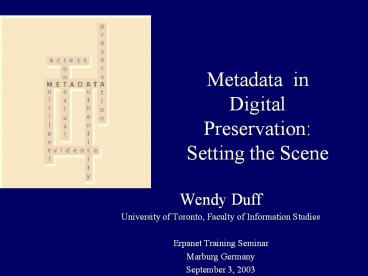Metadata in Digital Preservation: Setting the Scene - PowerPoint PPT Presentation
Title:
Metadata in Digital Preservation: Setting the Scene
Description:
Data 'factual information (as measurement of statistic) used as ... which describes, manages, and catalogues these resources in a consistent and efficient way. ... – PowerPoint PPT presentation
Number of Views:35
Avg rating:3.0/5.0
Title: Metadata in Digital Preservation: Setting the Scene
1
Metadata in Digital PreservationSetting the
Scene
- Wendy Duff
- University of Toronto, Faculty of Information
Studies - Erpanet Training Seminar
- Marburg Germany
- September 3, 2003
2
Outline
- Definitions
- Purpose and Functions
- MetaMap
- Principles and Practicalities
- Issues
3
Definitions
- Data about data
- Data factual information (as measurement of
statistic) used as a basis for reasoning,
discussion or calculations. (Webster) Can be
numbers, words, sentences, and/or records. - The prefix "meta" comes from the Greek and means
"among, with, after" or "change" (Webster).
4
Recordkeeping Metadata
- Structured or semi-structured information which
enables the creation, management, and use of
records through time and within and across
domains in which they are created. - Recordkeeping metadata can be used to identify,
authenticate, and contextualize records and the
people, processes and systems that create,
manage, and maintain and use them.(Archiving
Metadata Group)
5
Elements and Attributes
- Metadata are expressed as groups of elements and
attributes. The grouping of elements depends
upon their relationships. The elements and
attributes can be mandatory or optional.
6
Metadata Schemas
- Schemas are a framework that specifies and
describes a standard set of metadata elements and
their interrelationships. Schemas provide a
formal syntax (or structure) and semantics (or
definitions) for the metadata elements. (ISO
Metadata for Records)
7
Purpose and Functions
- Discovery and retrieval
- Control and management
- Preservation
- Ensure authenticity and integrity of records
- Provide context and meaning
- Rights management and security
- E-business
8
Metamap
- Mapping metadata initiatives, to try to show
relationships among them, and to connect them
with the various players involved in their
creation and use. - http//mapageweb.umontreal.ca/turner/meta/english/
metamap.html
9
Different Schemas
- People, professions, associations and
organizations with biases and various world views
develop metadata schema - categories are historically situated artifacts,
and like all artifacts, are learned as part of
membership in a community of practice Geoffrey
C. Bowker, and Susan Leigh Star, Sorting things
out Classification and its Consequences
(Cambridge, Mass. MIT Press, c1999.), p. 287
10
(No Transcript)
11
Bibliographic model
12
The View of Metadata for Discovery and Retrieval
- A metadata record is something which describes,
manages, and catalogues these resources in a
consistent and efficient way. This means that
someone looking for the resource is more likely
to find it. - (The New Zealand Locator Service (NZGLS) Metadata
Standard and Reference Manual)
13
The View of Metadata for Preservation
- Preservation Metadata will be used to
- store information supporting preservation
decisions and actions - document preservation processes, such as
migrations, transformations and emulations - record the effects of preservation processes
- ensure the authenticity of Preservation Masters
over time - enable objects for which the library has assumed
preservation responsibility to be identified.
Preservation metadata - (National Library of New Zealands metadata
standard framework)
14
Metadata Principles for Discovery and Retrieval
- Modularity
- Namespaces
- Extensibility
- Refinement
- Multilingualism
- Do these principles apply to preservation
metadata also?
15
Practicalities
- No one schema will accommodate all the functional
requirements of all applications. - Metadata needed for preservation will overlap
with metadata needed for discovery and retrieval
but they will also differ in content and level of
granularity.
16
Metadata Schema
- The content, semantic and syntax of a metadata
schema will depend upon the domain that
promulgates it, the function or purpose of the
schema, and the level of aggregation, the type of
objects and the type of entities to which it
relates - Represent different types of entities including
artifacts, persons, functions, business
processes, events, record systems.
17
Metadata Schemas and Models that Work Together
- OAIS
- A reference model
- Metadata Encoding and Transmission Standard
- (METS) developed by the library community,
provides a data structure for exchanging,
displaying, and archiving digital objects - NISO Z39.87 Technical Metadata for Digital Still
Images - describes what fields are necessary in a database
for preserving digital images.
18
METS
METS
Descriptive MD
Structural MD
Administrative MD
Behavioral MD
Digital Provenance
Technical
Source
IP Rights
NISO Z39.87
19
Issues
- No one metadata schema will fulfill all
functions, so how do we ensure interoperability
across schema? - Crosswalks are not a panacea
- Role of RDF supports the reuse and exchange of
vocabularies - How much standardization do we need?
- Can intelligent agents overcome the need to
standardize?
20
More Issues
- Long-term metadata viability
- Who will establish metadata registry?
- Who will develop tools for the registries?
- What metadata do you need to describe metadata
schema? - Who is responsible for metadata creation?
- People will not supply metadata unless they
benefit from doing so - How can the creation and authoring of metadata be
automated?
21
More Issues
- How much metadata is enough or too much
- Which attributes of a digital object do we have
to document? How much can we lose? - Costs and Benefits of Metadata
- How much does metadata cost to create, to manage?
- How can we reduce the cost of metadata creation
while increasing the benefits? - Limit the types of file formats?
- Tools for metadata extraction?
- Reuse metadata from other sources?
- Repurposing digital objects?
22
More Issues
- Implementation
- Need policies and procedures manuals and
standards for implementation - How do you choose the right metadata schema?
- Numerous schemas but which one is right for you?
- How much metadata can we import from other
sources? - Can you modify metadata taken other sources or
does metadata have intellectual property rights?































